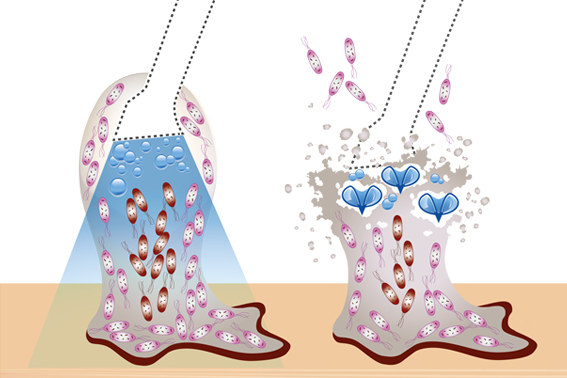
Ultrasonic-Assisted Wound Debridement (UAW)
Effective and gentle wound cleansing
Debridement plays an important role in the treatment of complex wounds. As part of wound management, it prepares the wound bed in order to promote a rapid and complete healing.
Ultrasonic-Assisted Wound Debridement (UAW) is a very effective and gentle method for the cleansing of chronic and acute wounds with a worldwide unique level of evidence. Even hard-to-reach areas can be debridated without an extensive surgical scenario. Wound treatment can be carried out on an outpatient basis and with local anesthesia by doctors or specialised nursing staff. In contrast to traditional sharp debridement procedures, the UAW disrupts adhering biofilms 1 and enables the effective removal of devitalized tissue in close proximity to healthy tissue. This results in a clean, viable wound bed 2,3,4,5 as well as a more rapid granulation 5. Antimicrobial therapies 6 and the body's own defence reactions can work better and the formation of new bacterial biofilms is impeeded2,3.
Ultrasonic technology in wound debridement
Söring's Ultrasonic-Assisted Wound Debridement uses the cavitation effect. The ultrasonic vibrations of the UAW instrument generate cavitation bubbles in the irrigation solution. Those bubbles implode due to pressure changes and generate strong sonic shock waves, so-called microjets. Devitalized tissue and foreign bodies are removed from the wound bed and biofilms are disrupted. Healthy tissue is hardly affected due to its higher elastin content, so that the healing process can proceed rapidly.
References
1 Geisler Crone, S., Garde, C., Bjarnsholt, T., Alhede, M.: A novel in vitro wound biofilm model used to evaluate low-frequency ultrasonic-assisted wound debridement. Journal of Wound Care 2015; 24:2, 64-72.
2 Yarets Y, Rubanov L, Shervchenko N. The biofilm-forming capacity of staphylococcus aureus from chronic wounds can be used for determining Wound-Bed Preparation methods. EWMA Journal 2013; 13(1):7-13
3 Yarets Y. Clinical experiences with Ultrasonic-Assisted Wound Debridement (UAW) used for wound bed preparation before skin grafting. Abstract for oral presentation at free paper session: Infection and Antimicrobials, EWMA conference, May 13-15, 2015; London, UK
4 Herberger K, Franzke N, Blome C, Kirsten N, Augustin M.: Efficacy, tolerability and patient benefit of ultrasound-assisted wound treatment versus
surgical debridement: a randomized clinical study, Dermatology. 2011; 222(3):244-9.
5 Lázaro-Martinéz JL et al. Preliminary case series results evaluating Ultrasonic-Assisted Wound Debridement (UAW) for treatment of complicated diabetic foot ulcers (DFU). Poster presentation, ISDF conference, May 20-23, 2015; The Hague, Netherland
6 Tested with a PHMB concentration of 0.04% (cf. with Ref. 1)

